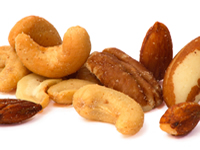 Fibre is very essential part of our diet, yet almost each and every diet we consume, fibre is not easy to find as most of our meals are prepared with too much processed foods.For given healthy meals, we should typically have approximately 25-30 grams of fibre in every day.World over most meals commonly will supply around 15 grams per day.So there is a regular shortfall of this important ingredient in the meals.
Fibre is very essential part of our diet, yet almost each and every diet we consume, fibre is not easy to find as most of our meals are prepared with too much processed foods.For given healthy meals, we should typically have approximately 25-30 grams of fibre in every day.World over most meals commonly will supply around 15 grams per day.So there is a regular shortfall of this important ingredient in the meals.Most common sources of high dietary fibre are whole grains, cereals, fruits and vegetables.Some legumes, pulses and nuts are also good sources for fibre.Only plant foods have fibre.
Fibres gives crispiness to grains, vegetables and fruits as well as crunch and snap on the bite of these foods.Oranges, grapes, strawberries, oats and beans are very good sources of fibre.Most processed food eliminates fibre from food e.g. fibre is eliminated from flour during the milling process.So, many processed cereals are without (or very little) fibre and so are white breads, pastries and cookies and biscuits.
Fibre defend us from several common health problems like lowering of LDL-Cholesterol (a bad cholesterol contributing in development of atherosclerosis-a phenomenon which clogs the arteries and reduces blood flow subsequently resulting in heart attack and stroke).
Liver forms bile salts and bile acids, needed in digestive process.Soluble fibre forms a thick gel that, moves slowly through intestines and binds to bile salts & bile acids packed with cholesterol and take them out of the body.The soluble fibre thus prevents some cholesterol reabsorption.As a result,liver have to make the shortfall in cholesterol (not reabsorbed) to be drawn from the circulating cholesterol in blood stream to manufacture more bile salts & bile acids.The nett result is fall in blood cholesterol levels. Most researchers agree high fibre in diet can reduce blood cholesterol levels by up 10-15 %, some claims it by as much as 30 % reduction.I will say even a 5-10 % reduction in blood cholesterole levels is valuable in slowing atherosclerosis.
People eating diets with regular high fibre contents also have a reduced risk of adult onset diabetes (Type-2 Diabetes). Good amount of fibre in every meal helps to keep blood sugars levels study.Fibre helps in slow but, adequate absorption of digested food for sustained release of glucose in the circulation and avoids the 'high and lows' encountered in low fibre diet in processed meals.This controls food craving and helps us feeling full for longer period.
 Fibre makes the undigested waste bulky, which propagates through the colon faster.This results in regular clearance of bowls, so avoid constipation. Quick flow and clearance of harmful wastes from colons reduces contact time between colonic lining and these harmful wastes.This plays a role in keeping mucousal epithelium (lining of colon) healthy and thus plays a role in prevention of colonic cancer,diverticulosis (ballooning of colon wall), diverticulitis (infection of the colon), haemorrhoids and constipation. All these diseases may not be prevented by adequate intake of high fibre alone, as there are other contributory factors in occurrence of these diseases.However, we can eliminate and reduce one environmental factor in causation of these diseases.
Fibre makes the undigested waste bulky, which propagates through the colon faster.This results in regular clearance of bowls, so avoid constipation. Quick flow and clearance of harmful wastes from colons reduces contact time between colonic lining and these harmful wastes.This plays a role in keeping mucousal epithelium (lining of colon) healthy and thus plays a role in prevention of colonic cancer,diverticulosis (ballooning of colon wall), diverticulitis (infection of the colon), haemorrhoids and constipation. All these diseases may not be prevented by adequate intake of high fibre alone, as there are other contributory factors in occurrence of these diseases.However, we can eliminate and reduce one environmental factor in causation of these diseases. Fibre is also key player in a healthy weight-loss program. Most food with high fibre are also naturally very low in fats. The small amount of fats in nuts and pulses contains polyunsaturated fats, and many fibre rich foods have high linoleic acid, an essential fat needed for good health.What more ideal food ingredient you need for weight loss,which is very filling and have no calories.
Research have clearly proved that, people who consume adequate fibre in their diets, weigh less by approximately 4-5 kgs over a decade compared to those who does not have regular adequate amounts of fibre in their diet.
Fibre makes meals more satisfying and stomach feels full with fewer calories.It is proven consistently that, breakfast cereals with high fibres like bran or porridge compared with low fibre like cornflakes will feel full for long and thus not crave for food.
 So, how do you know that, you have consumed enough required fibre for the day? Nutritionist often quote the "Frequency and flotation " to answer this question. Meaning how often you clear your bowl and how high your faecal contents floats, are two good indicators of your dietary fibre intake. And you guessed it right, more often and higher faecal matter indicates good amount of fibres in diet.
So, how do you know that, you have consumed enough required fibre for the day? Nutritionist often quote the "Frequency and flotation " to answer this question. Meaning how often you clear your bowl and how high your faecal contents floats, are two good indicators of your dietary fibre intake. And you guessed it right, more often and higher faecal matter indicates good amount of fibres in diet.Keep a little food diary until it becomes your second nature to include foods having high fibre.Ask yourself did your diet have enough whole grains, pulses, nuts, beans, fruits and vegetables.If you have missed them in the morning and/or in lunch then, make your dinner to compensate shortfall with appropriate choices.



Comments
{tag_commentlist}